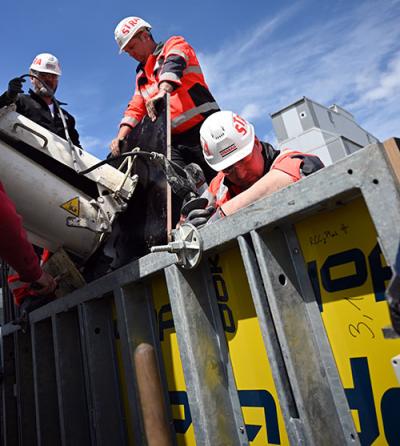Utilizing Low Carbon Concrete in Construction
Working with CO2-reduced concrete mixes

The construction industry accounts for 37 percent of global greenhouse gas emissions. If the sector were a country, it would rank third in global emissions after the USA and China. At Doka, we are committed to making a substantial contribution towards creating a sustainable future. Our pledge to reduce carbon emissions concentrates on more than just our processes. We also focus on key levers such as the building material concrete. We must understand that in the future, using concrete for construction is unavoidable. So, we need to work together to make concrete construction more eco-friendly.
Due to its unique physical properties, concrete has become indispensable in modern construction, especially when building or renovating key infrastructure. In the USA, for example, one in three bridges is in urgent need of major repair or replacement. Europe is facing similar challenges. In Germany, approximately 16,000 bridges require modernisation. Concrete is also essential for creating housing for a growing global population because by 2050, an additional 2.5 billion people will need housing.
Standard concrete contains cement. When taking a closer look at conventional concrete, approximately 80% of greenhouse gas emissions are emitted by cement clinker, which is thus responsible for a significant portion of greenhouse gas emissions (GHGs). Two main processes contribute to this climate problematic. First, the burning process, in which raw limestone is converted into cement clinker, requires very high temperatures (1,450°C), which means high fuel consumption and related emissions. Second, the chemical reaction during the burning process also releases CO2.
CO2-reduced concrete is significantly reduced in its potential to emit greenhouse gases compared to standard concrete. A key lever for this reduction in emissions is the radical reduction of clinker content. Reducing the clinker content in cement also reduces the associated CO2 emissions.
These new concrete mixtures behave differently from conventional concrete. The clinker, which contributes to rapid strength development, is environmentally harmful due to the high CO2 emissions in the burning process. When the clinker content is reduced, concrete takes longer to harden, especially in low temperatures. As a result, the formwork material has to remain on the construction site for a longer period of time, thereby increasing costs and resource use for the construction company.
What can Doka contribute to reducing CO2 emissions in concrete construction?
Our contribution to the decarbonisation of the construction industry is based on our own commitment to achieve net-zero emissions by 2040 and to create a long-term perspective for concrete construction through product innovation for our customers.
Steady, ongoing decarbonisation is a key element of our sustainability strategy. As one of the world's leading formwork manufacturers, we operate at the interface between formwork and concrete. We are developing new technologies to reduce CO2 in concrete and incorporating the latest research and results from our pilot projects. We also work closely with concrete producers and contractors. In the near future, intelligent formwork systems will help us to use environmentally friendly concrete cost-effectively on construction sites around the world.
Our goal is to continuously change concrete for the better to create concrete that is fit for a green future. By using advanced formwork technologies and continuously focusing on innovation, we aim to create added value for our customers, the industry and the environment.
Our mission is to support our customers in the development of CO2-reduced concrete mixes and their safe and efficient use on construction sites.

Doka solutions for CO2-reduced concrete mixes
Optimizing concrete mix design for lower CO2-emissions
Software, equipment and consultancy - for concrete suppliers and precast producers
Benefit from individual consultancy from our experts on how to reduce CO2 emissions in your concrete construction projects. Tailored consultancy and laboratory services aim for the reduction of energy consumption in concrete processing. Realise the potential by optimising concrete mixes and processes.
To use CO2 reduced concrete efficiently, insights into the early age strength development of the concrete mix are key. Determine and optimise the early age compressive strength with our Concrete Calibration Solution.
Working on site with CO2-reduced concrete mixes
Sensors, software and formwork - for construction companies. Productivity and safety with CO2-reduced concrete mixes on the jobsite
CO2 reduced concrete takes longer to harden, especially in low temperatures. Therefore it is all the more important to gain real-time insights into the early age strength development of the concrete structure. Our concrete monitoring solution Concremote measures early age compressive strength of concrete on site or at the precast plant. Thus CO2 reduced concrete can be managed efficiently and economically.
Researching the future of sustainable concrete construction
As of today, we have solutions at hand to support our customers in efficiently using CO2 reduced concrete in their construction projects. But we do not stop here. We are investing in the future of sustainable concrete construction.
Research projects range from optimizing concrete mixes with the help of artificial intelligence to developing a Functional Prototype of an Intelligent Heated Formwork. Here we are lifting the curtain on the latter.
RCC2 research project: CO2 savings of up to 80 per cent possible in construction with innovative concrete

The Austrian research study RCC2 (reduced carbon concrete) investigated the potential of innovative concrete mix designs to decarbonise concrete. The broad-based consortium tested ways of establishing CO2-reduced and even climate-neutral concrete as the new state of the art.
Their common goal is to overcome the technical, legal and economic hurdles of establishing CO2-reduced concrete as the new state of the art and to open the way for this climate-friendly building material on Austria's construction sites.
Final report RCC2 project
Are you looking for ways to reduce your carbon footprint in concrete construction?
Our experts are happy to help.

